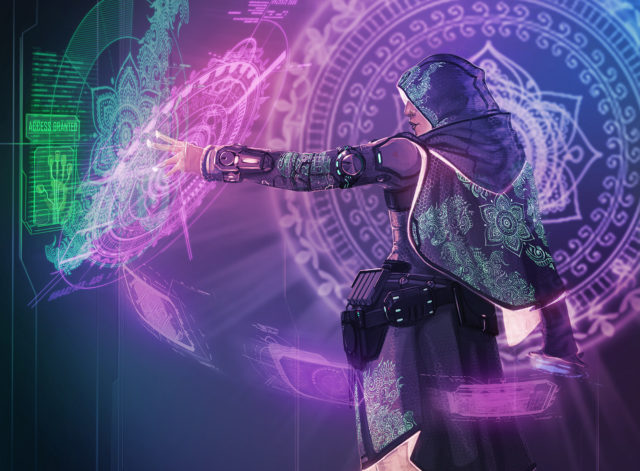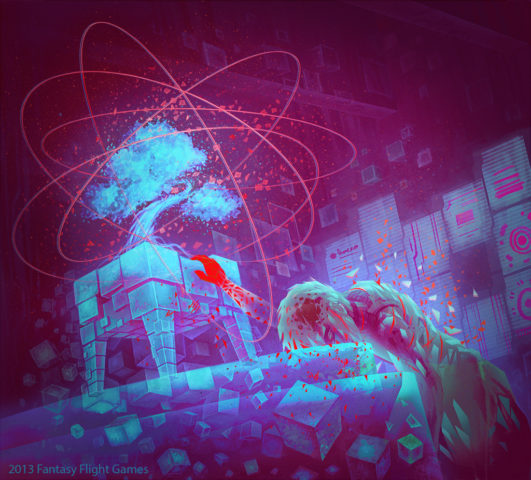Note: With this series I’m specifically interested in the way Netrunner expresses fiction through the interactions of its rules. These articles are not intended as analysis of cards in terms of their utility in competitive play.

Netrunner is a two player competitive card game that takes place within the Android universe, a fictional setting created by Fantasy Flight Games and originally devised for the game Android. As a living card game – with predetermined cards entering the available pool every few months – Netrunner is able to consistently build on its mechanics over time, allowing it to change and grow in ways that not only develop the game’s possibility space but also its fiction. This linking of mechanics and fiction is one of the strengths of Netrunner, and something that has kept me playing even through periods of stagnation in the competitive meta-game.
The ways in which runners and corporations use their assorted resources to wage cyber warfare, and the narratives thus created, help expand the fiction of the larger Android universe. This is further supported through the card art and flavour text. Specific characters can appear on multiple cards, where their presence helps contextualise not only the underlying fiction, but also the mechanics and card interactions themselves.
I am interested in examining the ways Netrunner represents its characters and organisations through mechanics; how it develops the fiction of the Android universe through card interactions, and the addition of new mechanics over time. To be able parse this fiction, to read Netrunner, we first need to understand the game’s core mechanics and foundation fictional elements.
Android: Netrunner is an asymmetric game of cyber-warfare waged between a runner (hacker) and a mega corporation. Corporations build servers protected by ICE (Intrusion Countermeasures Electronics) and attempt to advance their agendas; or simply remove the runner threat through direct action. Runners in turn construct their rigs, establish networks of resources, and deploy ICE breakers to breach corporate servers and steal their agendas.
Play unfolds sequentially with the corporation and the runner taking turns until one side wins. Only in a competitive time-limited game is a draw possible. Outside of card abilities players in Netrunner have a fixed number of clicks per-turn. Each click is spent on an action, from playing a card, to making a run on an opposing corporation’s server. Fictionally each turn is equivalent to a single day, while runners keep their own schedules and can take four actions per-day, corporations operate primarily during business hours and are therefore limited to three clicks.
Cards are draw from each player’s deck (known as R&D for the corporation) into their hand (grip for runners and HQ for corporations). By paying their associated cost in credits, cards can then either be played directly, or installed by placing them onto the table. Installed cards have a degree of permanence and in some cases can remain in play for the entire game. Cards that have been installed can be trashed, removing them from active play and sending them to either the heap (for runners) or the archives (for corporations). For the corporation each of these three locations is treated as a server, meaning that runners can access the cards within if they successfully make a run on it. These central servers require as much, if not more, protection than the remote servers the corporation establishes over the course of the game.

Runners:
Runners cards are divided into four different types: programs, hardware, resources, and events.
Programs are your software, they take up memory – of which four units are available as standard – and have abilities that can be executed for a cost. Most programs perform actions during a run on a corporation’s server: from Icebreakers that directly combat ICE, to cards that will allow you to perform some action when you access a server. As software that only exists within the cyber-realm, programs are some of the easiest cards to trash, but also have numerous ways of being returned to play.
Broadly speaking hardware represents your actual computer, your rig. As these are physical objects in the world they have a permanence that software lacks. Hardware is difficult to remove from play, and also almost impossible to bring back once it has been removed. If part of your rig gets trashed you’d better hope you have an actual replacement.
Resources symbolise the people, organisations, and non-physical utilities that runners can call on for support. Representations of people and organisations, resources are second only to programs in their susceptibility to being trashed. If the corporation can “tag” the runner, identifying them and their location, then any resource can be trashed for a single click and two credits. When the corporations knows who you are even your friends are at risk. Like hardware, as most resources are objects in the real world, there are very few ways to bring them back into play once they have been trashed.
Events are specific actions a runner can perform. These are most commonly ways of allowing you to perform more actions in a click than allowed by your standard abilities, or to perform those actions under special circumstances. With events you can draw multiple cards, installs cards at a reduced cost, or initiate a run on a server ignoring certain ICE.
While the cards in play are the tools available to the runner, the cards in their grip also serve as a conceptual representation of the runner themselves. Cards in your grip can be trashed through damage, which comes in three forms: net, meat, and brain. Each card trashed in this manner absorbs one point of damage, if more damage is inflicted than can be absorbed then the runner flatlines and the corporation wins.
Net damage is frequent and lightweight, it is damage inflicted to the runner in the cyber realm. Net damage is most commonly inflicted by ICE sub-routines, ones and two points at a time. As it is a form of non-physical damage there are programs and hardware that can negate or absorb net damage.
Meat damage is slightly less frequent, but can often be enough to kill the runner outright; flatline through meat damage is the most common form of runner death in Netrunner. Meat damage represents direct physical damage to the runner themselves, as such it usually requires that the corporation has been able to identify and tag the runner. Meat damage can only be negated by hardware or resources that exist within the physical world. Software cannot directly absorb meat damage, though it can prevent or otherwise restrict the means by which that damage is inflicted.
The most infrequent type of damage is brain damage. This generally only occurs in small quantities but it differs from the other types due to its persistence. When brain damage is inflicted cards are trashed from the runner’s grip as usual, and their maximum hand size is reduced by the same amount. Runner’s can die directly from brain damage if more is inflicted than they have cards in their grip, but they can also die to brain damage if they are ever left with a negative hand size at the end of their turn. Brain damage is inflicted most commonly by ICE, and there are few means of negating it.

Corporations:
Corporation cards are divided into five different types: agendas, ICE, assets, upgrades, and operations.
Agendas are the varied goals of the corporation. They are at the core of Netrunner, and constitute its primary win condition. Corporations need to execute on these plans by installing agendas in a server and advancing them by spending a click and a credit. Each agenda has an advancement cost and is worth a specified number of agenda points. When scored agendas grant the corporation abilities that different in utility and power depending on their advancement cost. If the runner is able to access an agenda before it is scored they can steal it, earning the agenda points for themselves. The first player to reach seven agenda points wins.
ICE are the means by which corporations protect their servers. They are obstacles the runner has to overcome in order to access the cards in the protected server. ICE can do a variety of things from simply ending the run, to inflicting damage, or destroying programs. ICE are defined by their type (barrier, code gate, sentry), their strength, and the number of sub-routines they possess. Each sub-routine that is not broken by a runner’s icebreakers resolves, and the effect it specifies is carried out. Though as a runner you want to get past ICE, sometimes it’s not possible or necessary to break all sub-routines, allowing a sentry to trash one of your programs might be worth it.
Assets are the divisions, subsidiaries, and executives the corporations rely on to operate. Installed one each to a server they operate much like resources do for the runner, providing consistent per-turn income and increasing the range of actions available. Though representative of organisations and individuals within the world, that these assets have to be installed in servers indicates they are less physically extant than resources. They represent the corporations current use of these assets not necessarily the assets themselves. As such, once a runner access an asset they can pay a cost to trash it. Corporations in turn have multiple ways to bring trashed assets back into play; the sever might have been destroyed but the asset itself remains.
Upgrades function in a similar manner to assets, with the exception that they can be installed in any server alongside an asset or agenda. The same mechanical and narrative rules apply to upgrades as to assets.
Operations are to corporations what events are to runners, ways of taking direct action and performing more actions per-turn that allowed by the standard abilities. Through operations corporations can: attempt to tag a runner, gain extra clicks, or advance cards at a reduced cost.
In order to allow corporations to carry out their business with security and secrecy, assets, upgrades and agendas are – with a limited number of exceptions – installed face-down. With assets and upgrades needing to be rezzed, for a cost, before they can be used. This allows the contents of a server to be hidden information. Furthermore, certain assets can be advanced using the same rules as advancing agendas. These advanceable assets usually perform stronger abilities than standard assets, and sometimes their strength is proportional to the number of times it has been advanced. In this way runners don’t know which, if any, of the cards the corporation has installed might be the agenda they want and which might be a harmless asset, or even a trap.
Though it is not possible to inflict damage on corporations they way you can against a runner, there are other restrictions on their behaviour that lead to their own loss conditions. At the start of their turn the corporation must draw a card from R&D, if this is not possible because there are no cards left then the runner wins; they have been able to outlast the corporation, draining them of assets and preventing them from advancing their agendas.
Though not an exhaustive breakdown of the rules of Netrunner this should help frame the rest of our analysis. Next we will look at the game’s different factions, and how the influence system helps differentiate and define them through delineation of their strengths and weaknesses.
2 replies on “Reading Netrunner: Introduction.”
Thanks for the breakdown. Netrunner is pretty solid, but given that it’s been out for so long, it’s intimidating to try jump into.
Also, glad you’re back.
Thanks.
Right now Netrunner is probably at the worst place to jump in. Hopefully within a few months it’ll have started card rotation, and the order cards will begin to cycle out. Once it does you won’t need to buy as many data packs to be up to date.